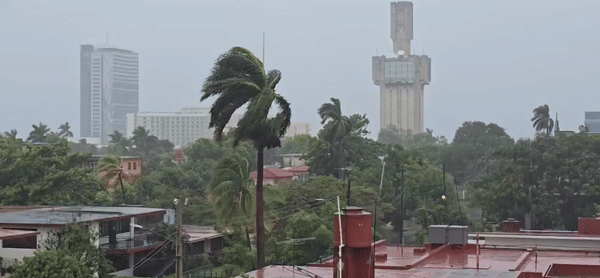Hurricane Rafael storms into Gulf after slamming Cuba, collapsing power grid

Hurricane Rafael churned in the open waters of the Gulf of Mexico on Thursday, moving away from Cuba after pummeling the country with flooding rain and knocking out its vulnerable electrical grid.
The storm was 200 miles west-northwest of Havana and 215 miles west of Key West, Florida, according to the National Hurricane Center's 10 a.m. EST update. With winds of 100 mph, Rafael remained at Category 2 strength, which it had weakened to as it barreled across Cuba.
Meteorologists discontinued the storm-related advisories and watches as Rafael was expected to "meander over the south-central Gulf of Mexico this weekend and early next week," steering well away from coastal areas. Forecasters say it will weaken and could possibly dissipate before reaching the western Gulf Coast.
Rafael made landfall late Wednesday afternoon in Cuba as a Category 3 storm, bringing a deluge that triggered flash floods and another island-wide blackout, furthering a crisis that has left many without power for over two weeks and which has been worsened by two consecutive hurricanes
Some 10 million people were without power across the country Thursday as Cuban authorities struggled to restore electricity. The country's state-run media said it had returned power to some areas but that the capital city of Havana largely remained in the dark.
As the storm pushed further into the Gulf, it will still produce mudslides and flooding along Cuba's higher terrain, with an additional 2 to 4 inches of rain forecast, the hurricane center said. Parts of western Cuba will see up to a foot of rain by the time Rafael moves completely away from the island.
Days before Rafael's landfall, tens of thousands of people evacuated the eastern province of Guantanamo after a series of storms produced torrential downpours and triggered flooding. By that point, the ground had already been saturated from the deluge wrought by Hurricane Oscar, a Category 1 storm that killed at least six people last month.
As a preventative measure, thousands were evacuated from Cuba's western provinces as Rafael made its approach, especially low-lying areas. The country also shut down government offices and closed schools. Jose Marti International Airport in Havana was scheduled to remain closed until at least late Thursday afternoon.
Will Rafael hit the US Gulf Coast?
The latest forecast tracks projected Rafael moving westward over the coming days, though it's unclear how long it will maintain its strength and how far west it will track.
"Once in the Gulf of Mexico, slight differences in Rafael's intensity and atmospheric steering winds could have a significant impact on its final track," Bill Deger, a senior meteorologist with AccuWeather said.
The probability of any U.S. landfall is extremely low, the latest AccuWeather forecast says.
A nontropical storm from the south-central U.S. could also impact the hurricane's direction, leading meteorologists to urge residents along the Gulf Coast to monitor Rafael through the rest of the weekend and into next week.
"It is also possible Rafael is torn apart by strong winds high in the atmosphere and dissipates in the Gulf of Mexico before making landfall," Deger said, noting expected weakening from cooler water and wind shear.
What happened to Hurricane Rafael's track?
The official forecast previously called for a possible landfall along the Gulf Coast between Alabama and Texas, but anyone tracking the graphic on Wednesday couldn't help but notice a southward shift expected later in the week.
Hurricanes are bumped, turned and steered by larger surrounding weather patterns. Computer models the hurricane center uses to help plot its forecasts take all of those conditions into account. While Rafael is now moving west-northwestward, the southward shift in the forecast occurred because a high-pressure ridge over the southwestern Atlantic is building and is expected to extend across the eastern Gulf of Mexico and remain for several days.
A number of the ensemble models – but not all – indicated Wednesday that ridge would help steer Rafael in a southwesterly to southerly direction. On Thursday morning, the center's forecast discussion stated most models continue to show a south or southwestward turn in response to the ridge.
Two models however still suggest a northward turn in response to a trough over the central U.S. The official track is sticking with the bulk of the models, but “there remains above average uncertainty in the future track,” the hurricane center said Thursday. The good news is if the storm were to take a more northerly path, it would encounter hostile conditions that would weaken it faster.
Another storm system could develop in the Caribbean
As Rafael moved further into the Gulf of Mexico, meteorologists watched the possible development of another storm system in the Caribbean Sea.
Located several hundred miles east-northeast of the Leeward Islands, the system could undergo gradual development over the next few days as it moves near the Greater Antilles. Formation over the next week was, however, considered "low" at 20%, down from 30% a day earlier, according to the hurricane center.
Showers and thunderstorms associated with the brewing system were expected to bring heavy rain to the northern Leeward Islands, the Virgin Islands, Puerto Rico, Hispaniola and the southeastern Bahamas through Saturday, the National Hurricane Center said.
The 2024 Atlantic Hurricane season proved well above average for both named storms and hurricanes, which meteorologists say has been fueled by record-warm oceans.
Rafael storm tracker
Contributing: Reuters; Jorge L. Ortiz and Doyle Rice, Paste BN.
(This story was updated to add new information.)